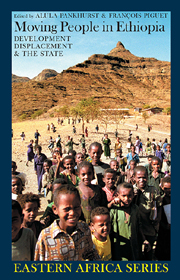Book contents
- Frontmatter
- Contents
- Acknowledgements
- Acronyms
- Glossary
- Notes on Contributors
- Preface: An Original Contribution to Country-wide Displacement Analysis
- Foreword by Alula Pankhurst & François Piguet
- Map
- Part I INTRODUCTION
- Part II THEORETICAL & INTERNATIONAL PERSPECTIVES
- Part III DEVELOPMENT-INDUCED DISPLACEMENT
- Part IV THE EXPERIENCE OF STATE-ORGANIZED RESETTLEMENT
- Part V THE DILEMMAS OF REFUGEES, RETURNEES & DISPLACED GROUPS
- Part VI CONCLUSION
- Bibliography
- Index
- EASTERN AFRICAN STUDIES
Preface: An Original Contribution to Country-wide Displacement Analysis
Published online by Cambridge University Press: 05 April 2013
- Frontmatter
- Contents
- Acknowledgements
- Acronyms
- Glossary
- Notes on Contributors
- Preface: An Original Contribution to Country-wide Displacement Analysis
- Foreword by Alula Pankhurst & François Piguet
- Map
- Part I INTRODUCTION
- Part II THEORETICAL & INTERNATIONAL PERSPECTIVES
- Part III DEVELOPMENT-INDUCED DISPLACEMENT
- Part IV THE EXPERIENCE OF STATE-ORGANIZED RESETTLEMENT
- Part V THE DILEMMAS OF REFUGEES, RETURNEES & DISPLACED GROUPS
- Part VI CONCLUSION
- Bibliography
- Index
- EASTERN AFRICAN STUDIES
Summary
Moving People in Ethiopia is the book long awaited by the international communities of researchers and practitioners working on forced resettlement processes and eager to understand and learn from Ethiopia's extraordinary experiences. It is also the book that, in my view, and rewardingly for the reader, fully meets head-on the unusual complexity of the many interwoven processes it examines historically, theoretically and empirically.
Resettlement processes in Ethiopia over the last 30-50 years have been so massive and frequent – or better said, so continuous – so nation-wide painful, so multi-causal and multi-form, that they secured for Ethiopia an unenviable special place in the history of the world's large-scale resettlements.
Ethiopia's unusual combination of displacement causes, types, magnitudes and outcomes has attracted international attention in many ways, ranging from the foreign donors' financial, technical or political assistance to the countless studies undertaken by social scientists, both Ethiopian and international. Yet, despite these innumerable studies, the intricate interwovenness of Ethiopia's population movements has proven hard to decipher plausibly and capture conceptually. It puzzled many scholars for many years, and it generated multiple contradictory and confusing interpretations. Controversies multiplied.
- Type
- Chapter
- Information
- Moving People in EthiopiaDevelopment, Displacement and the State, pp. xxv - xxxPublisher: Boydell & BrewerPrint publication year: 2009



